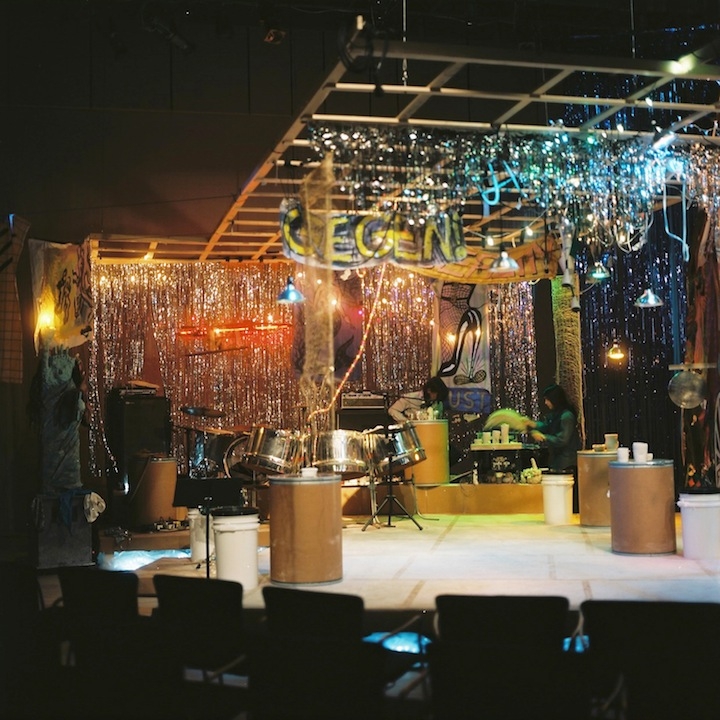“I’m leaving because this is bad. Because it’s really bad, isn’t it?” At a performance of the play Apartment (Mother Courage) (2015) by New Theater at the Whitney Museum, this statement/question was thrown into the audience by critic Claire Bishop as she dramatically walked out halfway through. Bishop happened to be sitting in the row in front of me, before she exited with a group of friends and colleagues. “Was that staged?” I heard someone behind me whisper. Later that evening I was at a friend’s birthday party, where one of the walkouts approached me, recognising that I had been seated behind him. “Did people think it was staged?” he asked.
The Whitney performance was to be the swansong for Berlin’s New Theater, a finale that was to draw to a close the activities of the artist-theatre project, run by Americans Calla Henkel and Max Pitegoff. Berlin is a place I rarely visit, so the only experience I had of their plays before the Whitney was Jory Rabinovitz’s play XY NAUGHT, which travelled from the Kreuzberg space to Abrons Arts Center on New York’s Lower East Side in 2014. I mention this because the project, as far as I understand it, operated as a form of scrappy community theatre, and was something of a for-us-by-us project, and I want to be clear that I can’t and don’t speak from that community. I had admired from afar, however, the way in which the project seemed to open up alternative space for thinking about what artists are doing and why they are doing it by opening a low-fi theatre instead of another clean, white box with fluorescent lighting, and by defining working together in terms of performing jobs or roles. Staging plays with artist friends and other members from a local social scene, the project had the kind of attitude that inevitably created insiders and outsiders; but that the moment at which the project transferred to a well-appointed museum was the moment that it drew its own kind of theatrical response (a declarative walkout) seems worth reflecting upon.
That audiences had to be ID’d when picking up tickets from the museum’s admissions desk and warned that alcohol would be served (so that there could be a bucket of Tecate at the entrance) is as good a sign as any that one space was sitting awkwardly in the other.
Not that there should be a problem with awkwardness. New Theater had elements that were professional, shambolic, compelling and serious. The articulations and voices of the plays veered between bad karaoke, political speech, hammy slapstick, pseudo and actual philosophy, in-jokes, standup comedy and discussions of meaning staged in a branch of Dunkin’ Donuts. The New York rendition of Apartment featured a steel-drum-and-vocal rendition of Madonna’s La Isla Bonita (1987) that was a joy to behold, but also some solemn notes about selling out and giving up. Published in this magazine, Karen Archey’s profile of New Theater (see ArtReview, April 2015) gave an elegant summation of Henkel and Pitegoff’s project and, in particular, the politics and risk of a type of embarrassment that connects people to each other. In Henkel’s words, ‘It’s a really deep love when you see someone onstage and feel afraid for them and it makes you connect in this bizarre, fucked-up way. I think this generosity happens more in this space where people don’t really know what they’re doing.’
Is this embarrassment, this awkwardness, the use of untrained actors and people who don’t know what they’re doing, the same thing as Bishop’s “this is bad”? The performances were certainly not slick. Did the brand-new theatre space in the beautiful new Whitney create different expectations? Possibly. But what does this tension between high-performance facilities and low production-values mean for curators of performance given that the former are being built in museums across the world? That Apartment’s meta-narrative, set in a bar threatened with closure, circled around the issues of nostalgia and gentrification that plague cities like New York and Berlin (it was better in the old days, it was cheaper in the old days, things had more political meaning in the old days) also connects to the gentrification of performance – high ticket prices, good facilities. When museums set up their institutional stall for professional theatre, they alter the readings of the unrehearsed and unprofessional in a way that incites a clash between the desire and the delivery – the audience is set up to feel wronged.
When I think of André Breton leaping onto the stage at Tristan Tzara’s play in 1923 and starting a fight, I think of artists within whose work something is at stake. Was it better in the old days? What’s at stake here between high performance culture and an amateur community? Work hard, be professional, answer your emails on time, talk the PR talk, don’t be late. Banker, ad executive, tech startup, artist, whatever. There’s nothing like looking at grainy 1970s photographs of downtown performances, but maybe running a project for yourself, then shutting it down with no statement, no photographs, no fanfare and no scaling up is a way to go against the grain today.
This article was first published in the January & February 2016 issue of ArtReview.
